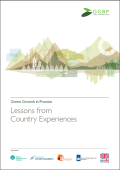This report investigates how cities can use different instruments to integrate the environment into urban planning and management approaches. Including: policy instruments, process instruments, planning instruments and management instruments. The report examines how these instruments are applied to several well established approaches to integrated urban planning. It examines the characteristics, strengths and weaknesses of Integrated Development Plans, City Development Strategies, ecoCity Planning, ecoBUDGET and Strategic Environmental Assessment.
The report also includes 12 case studies of cities that have worked to integrate the environment into their planning processes including: Egypt (Alexandria), Thailand (Bangkok), Republic of Cuba (Bayamo), the Philippines (Bohol), Bulgaria (Bourgas), Canada (Calgary), South Africa (Cape Town), Brazil (Goiânia; Porto Alegre), Columbia (Manizales), Kenya (Nakuru), and the People’s Republic of China (Yangzhou).

Green growth is becoming an attractive opportunity for countries around the world to achieve poverty reduction, environmental protection, resource efficiency and economic growth in an integrated way. Green growth strategies generate policies and programs that deliver these goals simultaneously. They accelerate investment in resource efficient technologies and new industries, while managing costs and risks to domestic taxpayers, businesses, communities and consumers.
This report carried out by the Green Growth Best Practice (GGBP) initiative, is the first comprehensive international assessment of lessons from experiences of pursuing green growth across all levels of government and all regions. The report is the result of a collaborative partnership between the Climate & Development Knowledge Network (CDKN), the European Climate Foundation (ECF) and the Global Green Growth Institute (GGGI). It engaged 75 authors in evaluating more than 60 programs around the world.
This report on inclusive green growth by infoDev and the World Bank reveals valuable insights from community outreach workshops conducted in South African townships for the Climate Innovation Center (CIC) in South Africa. The report does not present a one-size-fits-all solution to implement inclusive green growth strategies across all developing countries. The reports findings are observed in light of the Gauteng Climate Innovation Centre, which aims to facilitate and foster innovative clean technology entrepreneurship within the context of the surrounding township communities.

This paper offers an initial assessment of the use, potential usefulness and legality of local content requirements (LCRs) in renewable energy policy. By scrutinising existing empirical evidence on LCRs, the authors identify a number of initial basic conditions that determine the effectiveness of such measures in creating domestic industries. The paper provides an in depth analysis of the wind LCR in China, and descriptive analyses of other LCRs used in the promotion of renewable energy around the world. It further qualitatively addresses the question whether or not local content requirements and medium-term innovation could be aligned. Finally, it discusses the legality of the measures under WTO law.
Other case studies include Canada, Spain, Italy, France, Greece, Croatia, the United States, India, Brazil, South Africa and Turkey.
Developing countries are faced with the dual challenge of reducing poverty while improving management of natural capital and mitigating the emission of greenhouse gases (GHG) and local pollutants. The challenge is particularly acute for large, rapidly growing economies, such as India, China and Brazil. In 2007 the Energy Sector Management Program (ESMAP) and the World Bank began to provide support to countries to develop long-term frameworks for reducing GHG emissions in a way that is compatible with economic growth objectives. This report presents lessons learned from seven country studies. These include: countries must take the leading role; adopt a flexible approach and build a multi-disciplinary team; stakeholder engagement and consensus building is essential; allow sufficient time and resources; and invest in data and tools. The report is intended as a practical guide for government officials, practitioners and development agencies involved in low carbon development planning.
This summary was prepared by Eldis.
